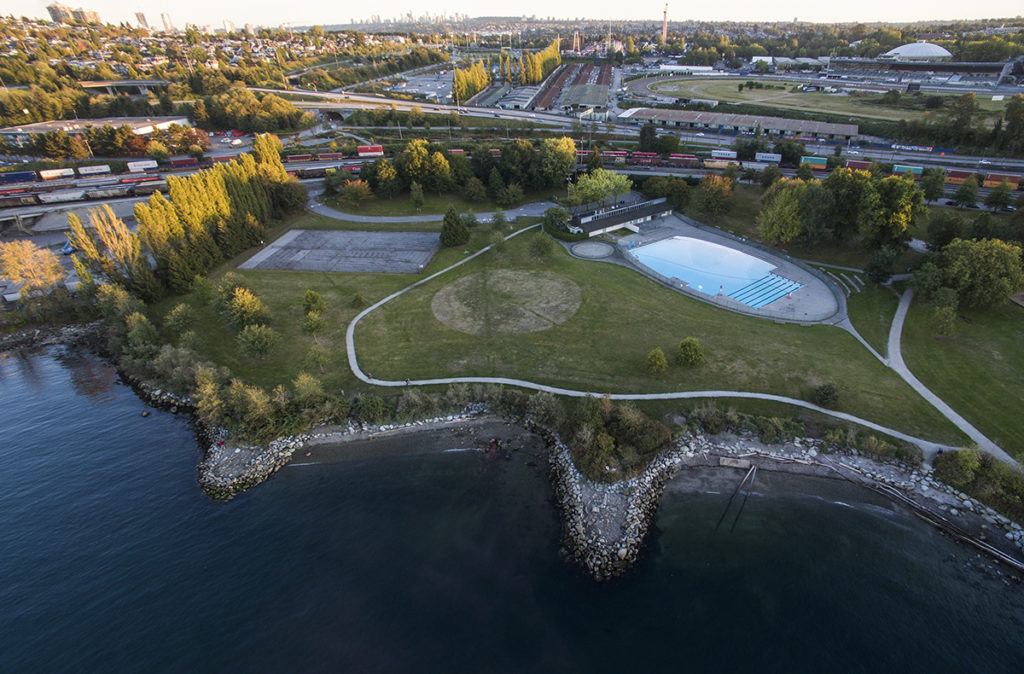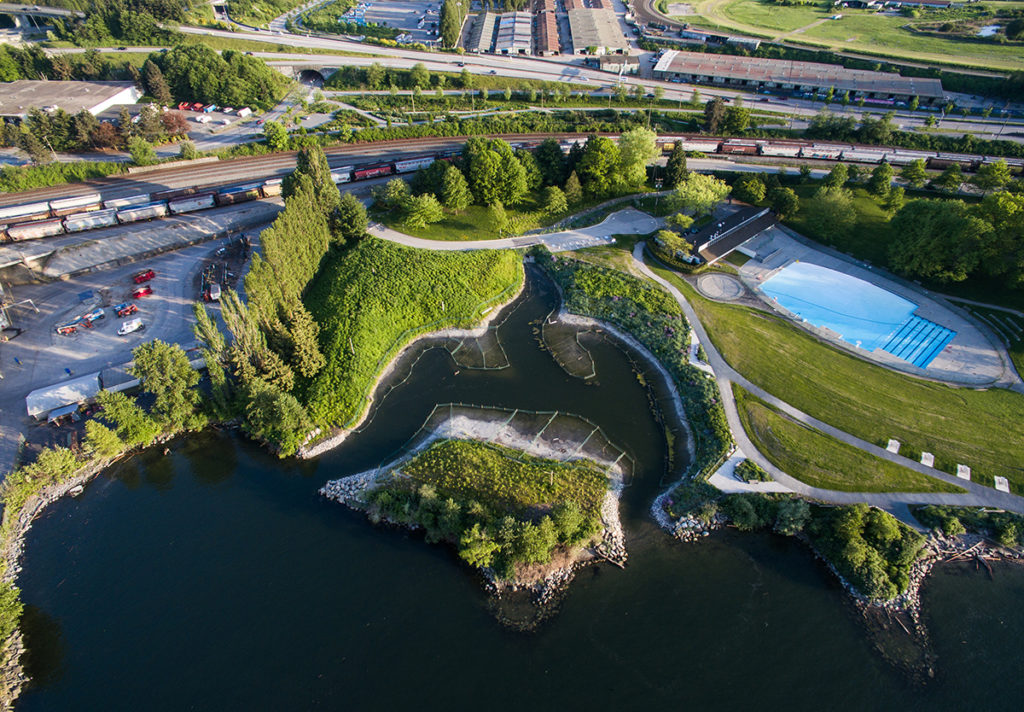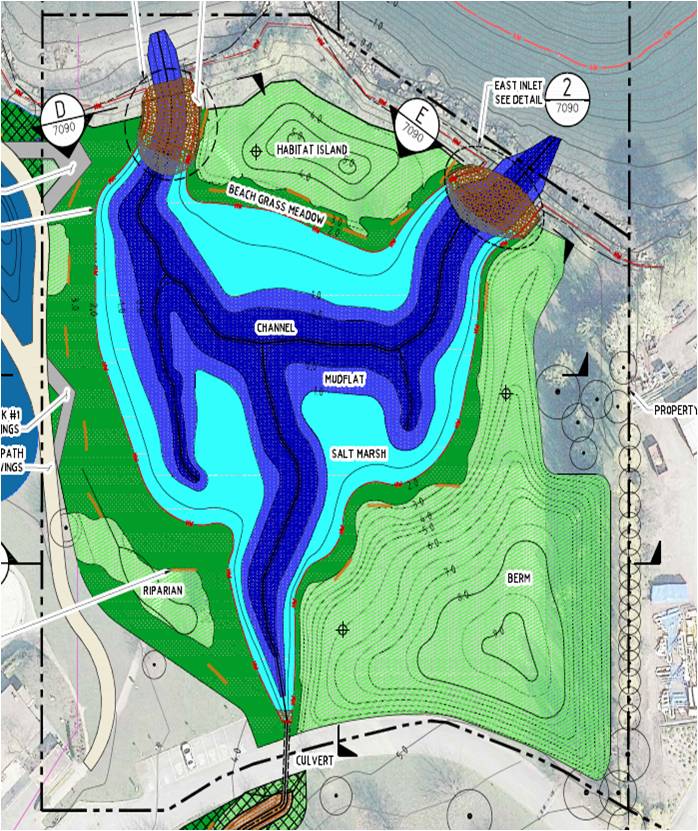Green Shores | Case Studies
New Brighton Park Shoreline Habitat Restoration Project



Project Overview
| Location: Vancouver, BC | Project area: 2.5ha |
| Year completed: 2018 | Awards: Finalist for the 2018 Environmental Managers Association of British Columbia’s Environmental Management Awards, and was a featured presentation regarding port cities and thriving environments at the 16th Annual World Conference of Cities and Ports |
| Shoreline length: the original shoreline length of 150m was elongated to 440m with the creation of tidal marsh channels | Shore type: Cobble and sand; previously hardened segments |
| Green Shores rating achieved: GOLD | Total points: 20* |
*Total points were assigned based on the Green Shores for Coastal Development Credits and Ratings system (2010).
Site Description
The project site is located along the south side of Burrard Inlet immediately west of the Second Narrows Bridge in Vancouver, B.C. The New Brighton Park Shoreline Habitat Restoration Project transformed what was formerly part of an industrial harbour into a restored coastal lagoon and marsh system. Through restoration of tidal influence and creation of enhanced shoreline habitat, which had been disturbed since the 1960s, the project helped to address the high mortality of juvenile chinook and chum salmon migrating through Burrard Inlet.
Historical Site Use
Burrard Inlet and nearby coastal areas have been used by Indigenous groups for millennia. The project site, New Brighton Park, was established circa the 1930s in an area that was formerly an industrial harbour and the site of Hastings Town – the original area of the City of Vancouver circa 1865. The site formerly contained a shingle mill. Since the 1960s, extensive filling of the intertidal zone occurred in the north portion of the park.
This shifted the shoreline by as much as 150 metres from its historical location, greatly reducing intertidal, backshore and marine riparian areas, vegetation, and habitat. This fill, being of unknown origin and quality, was tested and removed because of contamination.
Conceptual Design

Project Team and Affiliated Organizations
- Vancouver Fraser Port Authority
- Vancouver Board of Parks and Recreation
- Musqueam, Squamish and Tsleil-Waututh Nations
- Moffat & Nichol
- Hemmera Envirochem Inc.
- GL Williams & Associates Consulting
- Wilco Civil Inc.
- Connect Landscape Architecture
Project Objectives
Two major components were included in the New Brighton Park Shoreline Habitat Restoration project: habitat and park.
Aspects from both of these relate to the Green Shores objectives to restore the ecological features and functions of shoreline systems, and to encourage the sustainable use of shoreline ecosystems.
Work Plan
Due to its location within a high-use urban environment, extensive consultation was required to move this project through to successful completion. This included public consultation and collaboration with
the Musqueam, Squamish and Tsleil-Waututh Nations. The project area totalled approximately 2.5 hectares, of which 2.0 hectares were the newly created upper, mid and subtidal salt marsh areas, and enhanced instream and riparian habitat.
Description of how the project meets Green Shores principles
> Maintained/ Enhanced Habitat Function and Diversity
- Protected the sensitive wetland, particularly during the plant establishment phase, through installation of strategically located fences and shrub thickets
- Enhanced the presence of native vegetation through establishment of forest and shrub communities on the east side of the salt marsh, and beach grass meadows and shrub thickets on the west side of the salt marsh
- Completion of extensive planting program, including installation of about 25,000 salt marsh plugs, 200 native trees and 4,000 coastal shrubs
- Incorporated plants of cultural importance to Indigenous groups
- Restored critical habitat for birds, wildlife, fish such as juvenile salmon, and other marine species that feed along the shoreline of Burrard Inlet. This was done by removing existing riprap, and by removing previously placed industrial fill to create the intertidal salt marsh consisting of vegetated marsh area, mudflats, and tidal channels
> Preserved/Restored Shoreline Physical Processes
- Restored coastal wetland habitat by restoring tidal influence. This included creation of backshore, intertidal and subtidal habitat zones
- Restored the channel connecting Hastings Creek to the newly created saltwater marsh areas, while also creating new riparian habitat along the creek channel
- Sediment and erosion control during construction, including prevention of construction-related soil loss and reduction of sediment input to the receiving environment from construction-related run-off and stormwater
> Ecological Services Provided
- Restore biodiversity within the Hastings Creek channel by connecting the stream at Creekway Park with a new channel that flows through to the estuary
- Creation of additional intertidal and riparian habitat with an additional 290 m of shore length increased overall ecological function of a critical area for juvenile salmon (chum and chinook) and for resting and feeding shorebirds
- Installation of native vegetation species to support birds and shoreline fauna
> Additional Notes
- Measures were taken to prevent the risk of hazardous materials and contaminant spills, including oil, gas and hydraulic fluid
- Removal of contaminated material enhanced the ecological integrity of the site


